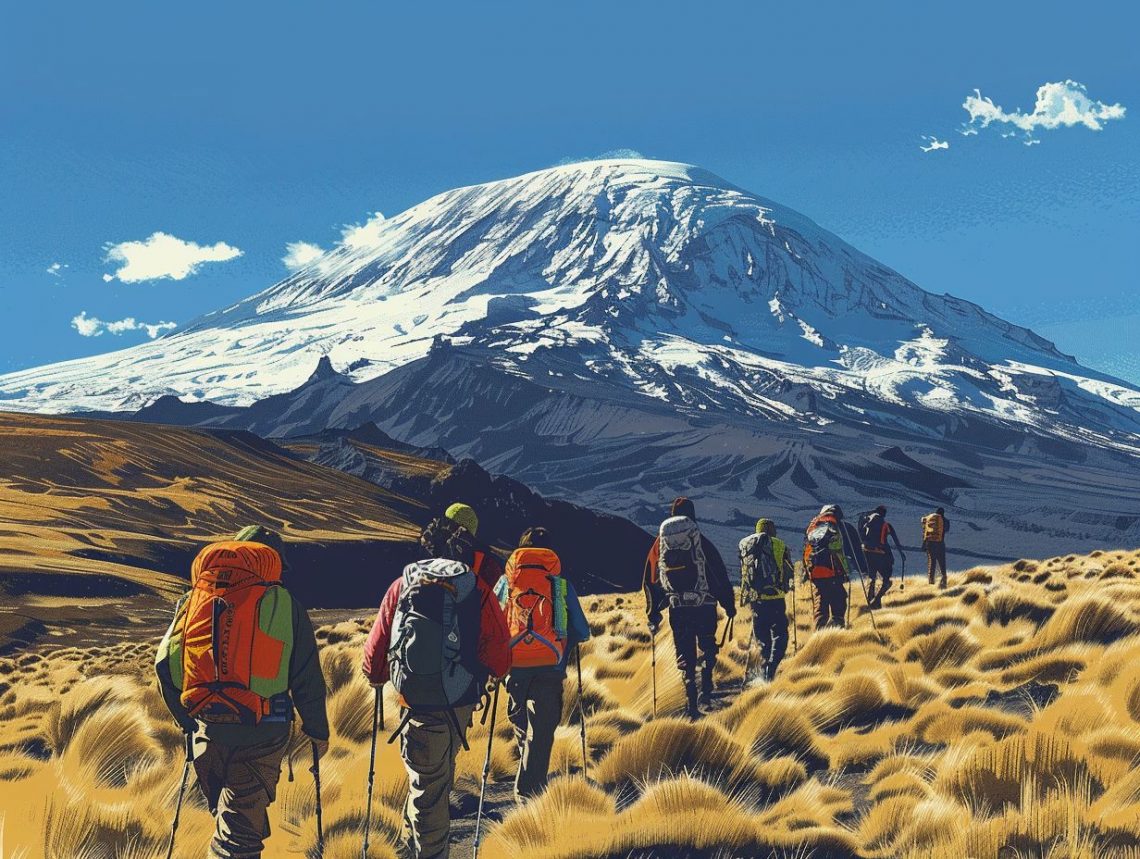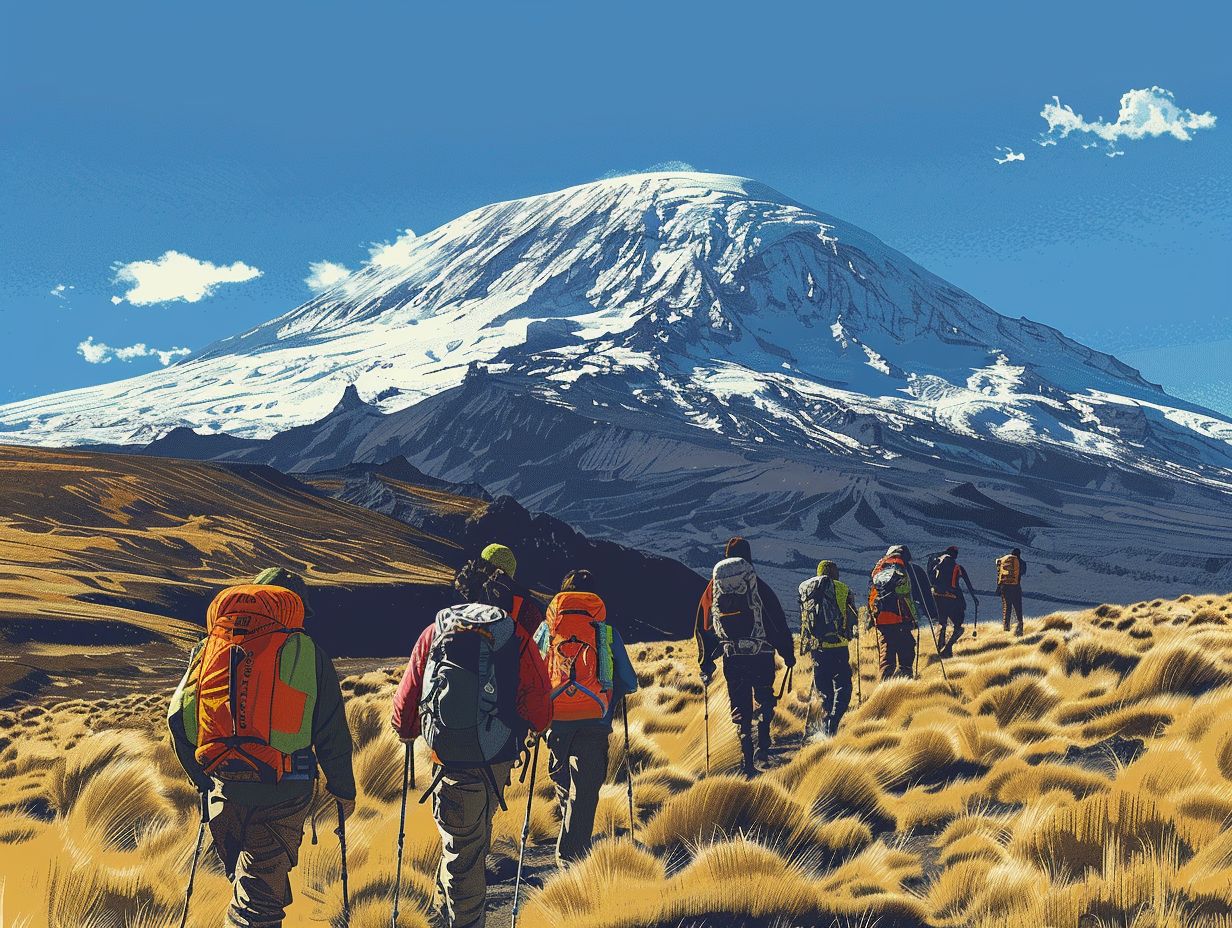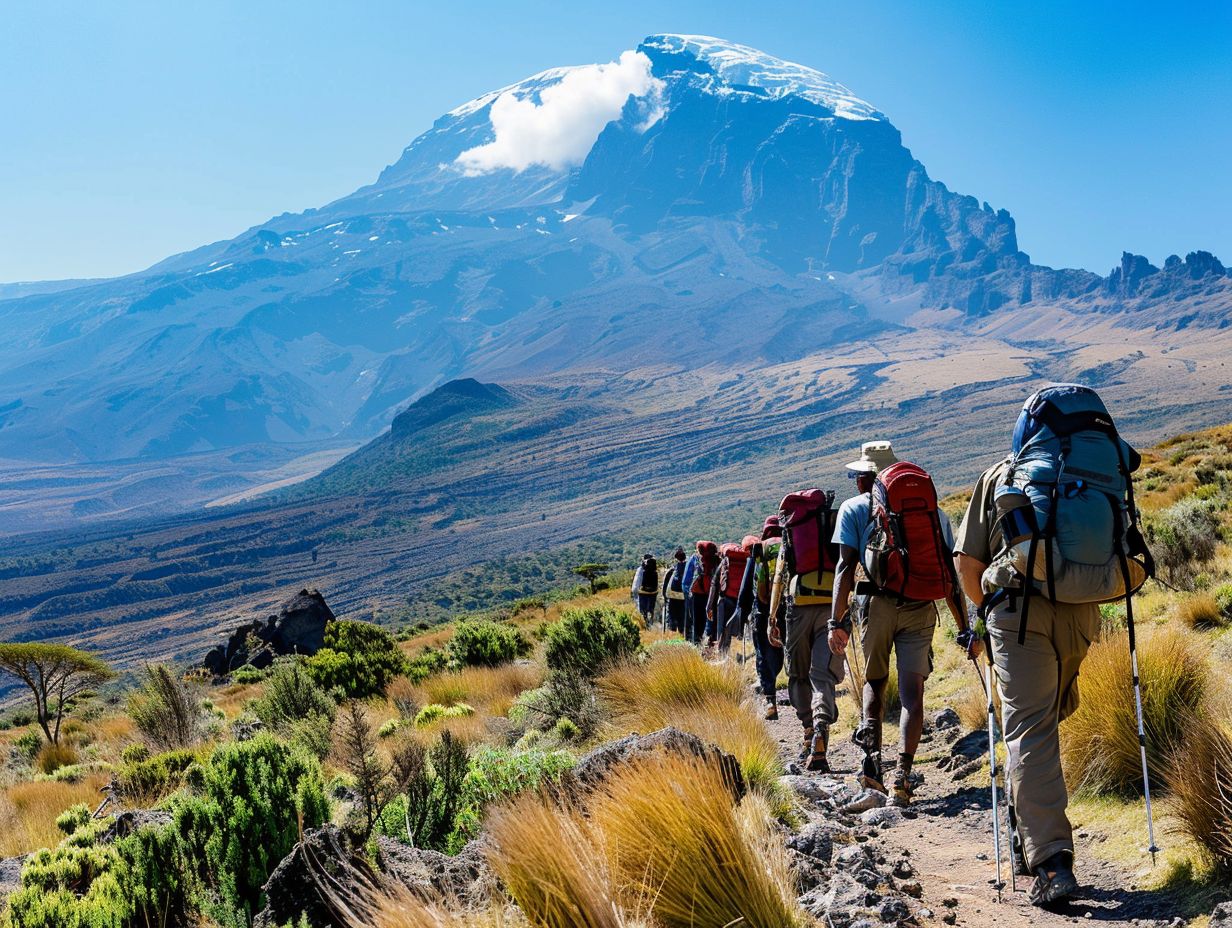
Climbing Kilimanjaro In August
Are you considering climbing Kilimanjaro in August? This article will provide you with all the information you need to know before embarking on this incredible adventure.
From the best time to climb Kilimanjaro to the physical requirements and gear needed, we have you covered. Discover the weather conditions, crowds, benefits, challenges, and highlights of climbing Kilimanjaro in August.
Get ready to prepare for an unforgettable experience on Africa’s highest peak!
Key Takeaways:

- The best time to climb Kilimanjaro is in August, when the weather is generally mild and stable, with less rain and lower humidity.
- Climbing Kilimanjaro in August offers the benefits of lower crowds, making for a more peaceful and enjoyable experience on the mountain.
- Proper physical training and preparation, as well as having the right gear, are crucial for a successful climb of Kilimanjaro in August.
Why Climb Kilimanjaro in August?
August is an ideal month to climb Kilimanjaro for those seeking favorable weather conditions and breathtaking views. It offers a unique opportunity to experience the mountain in all its glory.
During August, climbers are greeted with clear skies, allowing for unobstructed vistas of the surrounding landscapes, including the vast African plains stretching out below.
The visibility during this time is unparalleled, enhancing the overall climbing experience. The moderate temperatures in August provide a comfortable and enjoyable ascent, making it easier for climbers.
In August, the mountain is generally less crowded compared to peak tourist seasons, allowing for a more serene and intimate connection with nature.
What are the Weather Conditions in August?
August boasts relatively stable weather conditions on Kilimanjaro, with mild temperatures during the day and cool nights. The chances of encountering rainfall are lower compared to other months, enhancing the overall climbing experience.
- In August, climbers can expect average daytime temperatures ranging from 12 to 27 degrees Celsius, creating comfortable trekking conditions.
- The clear skies and reduced precipitation levels provide excellent visibility, allowing climbers to enjoy breathtaking panoramic views of the surrounding landscape.
- The lower chances of rainfall mean less slippery terrain, enhancing safety during the ascent.
These conditions make August an ideal month for climbers seeking a smoother and more enjoyable climbing experience on the majestic Kilimanjaro.
What are the Crowds Like in August?

August sees moderate crowds on Kilimanjaro, offering a balance between companionship and solitude during the climb.
The reduced number of climbers in August can create a more peaceful atmosphere, allowing individuals to immerse themselves in the serenity of the mountain.
With fewer people on the trails, there is a sense of calm and tranquility, enhancing the overall experience. This also provides climbers with better opportunities to connect with nature, without distractions or overcrowding.
Improved visibility allows for a clearer view of the breathtaking vistas and geological features, adding to the awe-inspiring moments along the journey.
What are the Benefits of Climbing Kilimanjaro in August?
Climbing Kilimanjaro in August offers several benefits, including higher chances of a successful summit due to favorable weather conditions and excellent opportunities for capturing stunning landscape photography.
August is considered one of the best months to conquer Mount Kilimanjaro. The climb during this time is known for having clear skies and lesser precipitation, making it safer and more enjoyable.
The well-established routes like the Machame and Lemosho Routes are more accessible and less crowded, allowing climbers to have a more serene experience.
The temperatures are milder, offering a comfortable environment for trekking. The breathtaking views of the surrounding landscapes, especially during sunrise and sunset, are impeccable.
Choosing August for your Kilimanjaro climb ensures you have memorable moments and high chances of reaching the summit.
Preparing for Kilimanjaro in August
Preparation is key when embarking on a Kilimanjaro expedition in August. From physical training to essential gear selection, ensuring readiness is paramount for a successful and safe climb.
Starting your physical preparation well in advance is crucial. Incorporate cardiovascular exercises like running and hiking to build stamina and endurance.
Strength training focusing on legs, core, and upper body will help you tackle the mountain’s demands. As for gear, investing in quality clothing, proper footwear, a sturdy backpack, and a reliable tent is essential.
Don’t forget to pack layers for changing weather conditions on the mountain. Remember, acclimatization is key, so take it slow and steady to avoid altitude sickness.
Listen to your guides, stay hydrated, and enjoy the breathtaking journey to the summit.
What are the Physical Requirements for Climbing Kilimanjaro?
Climbing Kilimanjaro demands a certain level of physical fitness and endurance due to the high altitude and challenging terrain. Being adequately prepared physically is essential for a smooth and successful ascent.
At an elevation of over 19,000 feet, climbers face reduced oxygen levels, harsh weather conditions, and steep inclines, all of which require a significant level of physical stamina.
Whether trekking through the lush rainforest, navigating rocky paths, or enduring long stretches of hiking, climbers must maintain a steady pace and demonstrate exceptional strength throughout the climb.
Preparatory training involving cardio workouts, strength training, and high-altitude simulation exercises are crucial for building the necessary endurance and fitness required to tackle this majestic peak.
What Gear Do You Need for Climbing Kilimanjaro in August?
Climbing Kilimanjaro in August requires specific gear to ensure comfort, safety, and protection from the elements. From insulated clothing to sturdy footwear, having the right gear is essential for a successful climb.
When preparing for a Kilimanjaro expedition in August, layers of clothing play a crucial role. Start with a moisture-wicking base layer to keep sweat away from the skin, followed by an insulating layer and a waterproof outer shell.
Durable hiking boots with ankle support are a must for traversing varied terrain. Don’t forget to pack essentials like a headlamp, trekking poles for stability, and a high-quality backpack to carry your gear.
Ensuring you have the right safety gear, including a first aid kit and emergency communication devices, is paramount for a successful climb.
What are the Training Tips for Climbing Kilimanjaro?
From cardiovascular exercises to altitude simulations, incorporating targeted training tips can enhance your chances of a successful summit.
One essential aspect of training for Kilimanjaro is building strength and endurance through a combination of hiking, running, and weight training.
Incorporating long hikes with elevation gain can help prepare your muscles for the sustained effort required during the climb. Consider including interval training to improve cardiovascular fitness and stamina.
Altitude acclimatization is vital for Kilimanjaro success. Prepare by using simulated altitude training like hypoxic tents or altitude simulation rooms. Gradual exposure to increased altitudes can also aid in acclimatization.
Creating a training regime that includes a mix of physical exercises, such as circuit training, yoga, and Pilates, can help improve your overall strength, flexibility, and balance.
Consistency in training, along with proper nutrition and hydration, is key to optimizing performance during the Kilimanjaro climb.
Incorporating specific exercises to strengthen the core muscles, including the legs, back, and core, can enhance stability and endurance on the mountain.
What to Expect During the Climb in August

Embarking on a Kilimanjaro climb in August promises a diverse and exciting journey filled with unique experiences. From challenging trails to breathtaking vistas, climbers can expect a memorable adventure ahead.
During the climb, climbers will encounter a variety of landscapes, ranging from lush rainforests to barren alpine deserts, showcasing the diversity of the terrain on the mountain.
The typical itinerary for a Kilimanjaro ascent in August often includes stops at iconic campsites such as Machame, Barranco, and Karanga, providing opportunities to rest and acclimatize.
Accommodations on the mountain primarily consist of sturdy tents equipped with sleeping bags and thermal mats, offering a comfortable respite after a day of strenuous hiking.
Although the climb presents its challenges, such as altitude sickness and unpredictable weather conditions, the sense of accomplishment upon reaching the Uhuru Peak, the highest point on Kilimanjaro, is unparalleled.
What is the Itinerary for Climbing Kilimanjaro in August?
The climbing itinerary for Kilimanjaro in August typically follows a structured route that aligns with the climbing season. Each day presents new challenges making the journey both physically demanding and visually rewarding.
In the morning, climbers usually start with a hearty breakfast before setting off on the trail.
The Machame route is a popular choice for the first few days, offering stunning views of the rainforest canopy. As the ascent continues, trekkers pass through various eco-zones, witnessing the transition from lush greenery to barren alpine desert.
Each day’s hike is interspersed with brief rest stops to catch your breath, refuel, and acclimatize to the altitude.
Notable landmarks such as Lava Tower and Barranco Wall add excitement and challenge to the journey, while campsites like Shira Camp and Barafu Camp provide essential respite at the end of each day’s trek.
What are the Accommodations Like?
Accommodations during a Kilimanjaro climb in August range from cozy mountain huts to tent campsites, providing climbers with essential shelter and facilities to rest and rejuvenate after a day of trekking.
For climbers seeking a communal experience and a chance to connect with fellow trekkers, the mountain huts offer shared living spaces, bunk beds, and basic amenities.
These huts, strategically located along the routes, often have a cozy atmosphere and provide a sense of camaraderie among climbers.
On the other hand, camping sites allow adventurers to immerse themselves in the rugged wilderness, offering a more independent and nature-centric lodging experience.
Whichever option you choose, both mountain huts and camping sites facilitate well-deserved rest and relaxation amidst Kilimanjaro’s breathtaking scenery.
What are the Challenges of Climbing Kilimanjaro in August?

Challenges abound when climbing Kilimanjaro in August, ranging from altitude sickness to unpredictable weather conditions. Staying safe, adapting to trail challenges, and maintaining a steady pace are crucial aspects of overcoming these obstacles.
Altitude sickness is a prevalent concern faced by climbers, as the thin air poses significant challenges to the body’s oxygen intake. The extreme altitude can lead to symptoms like nausea, dizziness, and fatigue.
The ever-changing weather conditions on Kilimanjaro in August can range from scorching sun to icy winds, requiring climbers to be well-prepared with appropriate gear.
Trail conditions can also present obstacles, with rugged terrain, steep inclines, and potentially icy patches making the ascent physically demanding. To mitigate risks, climbers should focus on acclimatization, hydration, and steady pacing to avoid overexertion.
Proper planning and listening to your body’s signals are essential for a safe and successful climb up the majestic Kilimanjaro.
What are the Highlights of Climbing Kilimanjaro in August?
The highlights of climbing Kilimanjaro in August include reaching the majestic summit, witnessing stunning sunrises, and capturing breathtaking panoramic views of the surrounding landscape.
Each milestone achieved during the climb adds to the sense of accomplishment and awe. As you ascend through the diverse ecological zones of Kilimanjaro, you’ll be immersed in a magical journey.
The vibrant hues of endemic flora, the symphony of bird calls echoing through the lush rainforest, and the stark beauty of the alpine desert create a sensory experience unlike any other.
Meeting fellow trekkers from around the globe, sharing stories around the campfire, and encouraging each other through challenging stretches foster a sense of camaraderie that enriches the entire expedition.
Frequently Asked Questions
1. What is the weather like when climbing Kilimanjaro in August?
A: August is considered one of the best months to climb Kilimanjaro as the weather is relatively dry and warm. Temperatures during the day can range from 10-20 degrees Celsius, while at night it can drop to below freezing.
2. Do I need any special gear or equipment to climb Kilimanjaro in August?
A: Yes, it is important to have proper gear and equipment when climbing Kilimanjaro in August. This includes warm and waterproof clothing, sturdy hiking boots, and a good quality sleeping bag. It is also recommended to have a guide and porters to assist with carrying equipment.
3. How difficult is it to climb Kilimanjaro in August?
A: Climbing Kilimanjaro is a challenging endeavor, regardless of the month. However, August is considered a good time to climb as the paths are generally dry and the weather is favorable. It is important to have a good level of physical fitness and to acclimatize properly to the altitude.
4. What is the best route to take when climbing Kilimanjaro in August?
A: There are several routes to choose from when climbing Kilimanjaro in August, including the popular Machame and Lemosho routes. It is recommended to choose a longer route to allow for better acclimatization and to increase chances of reaching the summit.
5. Can I climb Kilimanjaro in August if I have no previous climbing experience?
A: It is not recommended to attempt climbing Kilimanjaro in August if you have no previous climbing experience. The altitude and terrain can be challenging and it is important to have some level of experience and physical fitness before attempting the climb.
6. Is it safe to climb Kilimanjaro in August?
A: With proper preparation, equipment, and a knowledgeable guide, climbing Kilimanjaro in August can be a safe and enjoyable experience. However, it is important to be aware of the risks and to follow safety guidelines, such as acclimatizing properly and listening to your guide’s instructions.